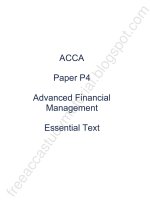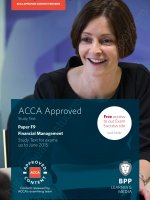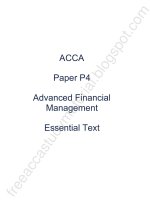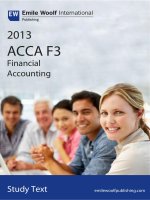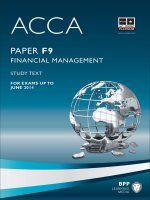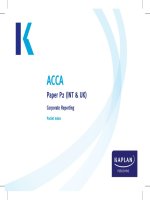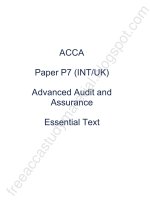ACCA f3 KAPLAN ESSENTIAL TEXT
Bạn đang xem bản rút gọn của tài liệu. Xem và tải ngay bản đầy đủ của tài liệu tại đây (11.09 MB, 348 trang )
ACCA
Paper F3 (INT)
Financial accounting
The Essential Text
British library cataloguinginpublication data
A catalogue record for this book is available from the British Library.
Published by:
Kaplan Publishing UK
Unit 2 The Business Centre
Molly Millars Lane
Wokingham
Berkshire
RG41 2QZ
ISBN 978 1 84710 537 0
© Kaplan Financial Limited, 2008
Printed and bound in Great Britain
Acknowledgements
We are grateful to the Association of Chartered Certified Accountants and the Chartered Institute of
Management Accountants for permission to reproduce past examination questions. The answers have
been prepared by Kaplan Publishing.
All rights reserved. No part of this publication may be reproduced,stored in a retrieval system, or
transmitted, in any form or by any means, electronic, mechanical, photocopying, recording or
otherwise, without the prior written permission of Kaplan Publishing.
ii
KAPLAN PUBLISHING
Contents
Page
Chapter 1
Introduction to accounting
1
Chapter 2
Statement of financial position and income
statement
9
Chapter 3
Double entry bookkeeping
29
Chapter 4
Inventory
55
Chapter 5
Sales tax
75
Chapter 6
Accruals and prepayments
85
Chapter 7
Irrecoverable debts and allowances for
receivables
97
Chapter 8
Noncurrent assets
113
Chapter 9
From trial balance to financial statements
143
Chapter 10
Books of prime entry and control accounts
155
Chapter 11
Control account reconciliations
175
Chapter 12
Bank reconciliations
185
Chapter 13
Correction of errors and suspense accounts
197
Chapter 14
Applications of information technology
211
Chapter 15
Incomplete records
219
Chapter 16
Partnerships
239
Chapter 17
Company accounts
259
Chapter 18
Accounting standards
285
Chapter 19
Statement of cash flows
303
Chapter 20
The regulatory and conceptual framework
329
KAPLAN PUBLISHING
iii
iv
KAPLAN PUBLISHING
chapter
Introduction
Paper Introduction
v
Introduction
How to Use the Materials
These Kaplan Publishing learning materials have been
carefully designed to make your learning experience as easy
as possible and to give you the best chances of success in
your examinations.
The product range contains a number of features to help you
in the study process. They include:
(1) Detailed study guide and syllabus objectives
(2) Description of the examination
(3) Study skills and revision guidance
(4) Complete text or essential text
(5) Question practice
The sections on the study guide, the syllabus objectives, the
examination and study skills should all be read before you
commence your studies. They are designed to familiarise
you with the nature and content of the examination and give
you tips on how to best to approach your learning.
The complete text or essential text comprises the main
learning materials and gives guidance as to the importance
of topics and where other related resources can be found.
Each chapter includes:
vi
•
The learning objectives contained in each chapter,
which have been carefully mapped to the examining
body's own syllabus learning objectives or outcomes.
You should use these to check you have a clear
understanding of all the topics on which you might be
assessed in the examination.
•
The chapter diagram provides a visual reference for
the content in the chapter, giving an overview of the
topics and how they link together.
•
The content for each topic area commences with a
brief explanation or definition to put the topic into context
before covering the topic in detail. You should follow
your studying of the content with a review of the
illustration/s. These are worked examples which will help
you to understand better how to apply the content for the
topic.
KAPLAN PUBLISHING
•
Test your understanding sections provide an
opportunity to assess your understanding of the key
topics by applying what you have learned to short
questions. Answers can be found at the back of each
chapter.
•
Summary diagrams complete each chapter to show
the important links between topics and the overall
content of the paper. These diagrams should be used to
check that you have covered and understood the core
topics before moving on.
•
Question practice is provided at the back of each text.
Icon Explanations
Definition Key definitions that you will need to learn from
the core content.
Key Point Identifies topics that are key to success and are
often examined.
Expandable Text Expandable text provides you with
additional information about a topic area and may help you
gain a better understanding of the core content. Essential
text users can access this additional content online (read it
where you need further guidance or skip over when you are
happy with the topic)
Illustration Worked examples help you understand the
core content better.
Test Your Understanding Exercises for you to complete
to ensure that you have understood the topics just learned.
Tricky topic When reviewing these areas care should be
taken and all illustrations and test your understanding
exercises should be completed to ensure that the topic is
understood.
For more details about the syllabus and the format of your
exam please see your Complete Text or go online.
Online subscribers
Paper introduction
Syllabus objectives
Paperbased examinations tips
KAPLAN PUBLISHING
vii
Introduction
Study skills and revision guidance
Preparing to study
Effective studying
Further reading
You can find further reading and technical articles under the
student section of ACCA's website.
viii
KAPLAN PUBLISHING
chapter
1
Introduction to accounting
Chapter learning objectives
Upon completion of this chapter you will be able to:
define accounting
•
explain the different types of business entity:
– sole trader
–
partnership
–
limited liability company
•
explain who users of the financial statements are and their
information needs
•
•
explain the nature, principles and scope of accounting
explain how the accounting system contributes to providing useful
information and complies with organisational policies and
deadlines.
1
Introduction to accounting
1 Definition of accounting
2 Types of business entity
A business can be organised in one of several ways:
•
•
•
Sole trader – a business owned and operated by one person.
Partnership – a business owned and operated by two or more people.
Company – a business owned by many people and operated by many
(though not necessarily the same) people.
Expandable text
2
KAPLAN PUBLISHING
chapter 1
3 Users of the financial statements
Test your understanding 1
Why do you think the following user groups are interested in a
company’s financial statements?
•
•
•
•
•
•
•
•
•
Management
Investors and potential investors
Employees and trade union representatives
Lenders
Government agencies
Suppliers
Customers
Competitors
The public.
KAPLAN PUBLISHING
3
Introduction to accounting
4 Types of accounting
Expandable text
5 How an accounting system contributes to providing useful
information
The main features of an accounting system and how it helps in providing
information to the business are as follows:
4
•
In a computerised system all information about the business
transactions can be quickly accessed. This will help in decision making.
•
It provides details of transactions of the business in the relevant
accounts.
•
When the accounts are closed off the balances for each outstanding
account are determined. This will give the value of assets and liabilities
in the business.
•
•
It gives a summary of outstanding balances.
This summary can then be used for the preparation of financial
statements.
KAPLAN PUBLISHING
chapter 1
•
Normally the financial statements are prepared at regular intervals. The
accounting system will allow the business to obtain the data and also
prepare the financial statements to determine the profitability, liquidity,
risks, etc. applicable to the business for a particular period. For internal
reporting purposes this could be monthly, whilst for external reporting
purposes this is usually yearly.
KAPLAN PUBLISHING
5
Introduction to accounting
Chapter summary
6
KAPLAN PUBLISHING
chapter 1
Test your understanding answers
Test your understanding 1
•
Management need detailed information in order to control their
business and plan for the future. Budgets will be based upon past
performance and future plans. These budgets will then be compared
with actual results. Information will also be needed about the
profitability of individual departments and products. Management
information must be very up to date and is normally produced on a
monthly basis.
•
Investors and potential investors are interested in their potential
profits and the security of their investment. Future profits may be
estimated from the target company’s past performance as shown in
the income statement. The security of their investment will be
revealed by the financial strength and solvency of the company as
shown in the statement of financial position. The largest and most
sophisticated groups of investors are the institutional investors, such
as pension funds and unit trusts.
•
Employees and trade union representatives need to know if an
employer can offer secure employment and possible pay rises. They
will also have a keen interest in the salaries and benefits enjoyed by
senior management. Information about divisional profitability will
also be useful if a part of the business is threatened with closure.
•
Lenders need to know if they will be repaid. This will depend on the
solvency of the company, which should be revealed by the statement
of financial position. Longterm loans may also be backed by
‘security’ given by the business over specific assets. The value of
these assets will be indicated in the statement of financial position.
•
Government agencies need to know how the economy is
performing in order to plan financial and industrial policies. The tax
authorities also use financial statements as a basis for assessing
the amount of tax payable by a business.
•
Suppliers need to know if they will be paid. New suppliers may also
require reassurance about the financial health of a business before
agreeing to supply goods.
•
Customers need to know that a company can continue to supply
them into the future. This is especially true if the customer is
dependent on a company for specialised supplies.
•
Competitors wish to compare their own performance against that
of other companies and learn as much as possible about their rivals
in order to help develop strategic plans.
KAPLAN PUBLISHING
7
Introduction to accounting
•
The public may wish to assess the effect of the company on the
economy, local environment and local community. Companies may
contribute to their local economy and community through providing
employment and patronising local suppliers. Some companies also
run corporate responsibility programmes through which they support
the environment, economy and community by, for example
supporting recycling schemes.
8
KAPLAN PUBLISHING
chapter
2
Statement of financial
position and income
statement
Chapter learning objectives
Upon completion of this chapter you will be able to:
•
explain the main elements of financial statements:
– statement of financial position
–
income statement
•
•
•
explain the purpose of each of the main statements
•
•
•
define assets and liabilities
•
•
draft a simple statement of financial position in vertical format
•
explain how and why revenue and expenses are disclosed in the
income statement
•
illustrate how the statement of financial position and income
statement are interrelated
•
draft a simple income statement in vertical format
list the main types of business transactions
explain how the accounting equation and business entity
convention underpin the statement of financial position
identify examples of receivables and payables
explain how and why assets and liabilities are disclosed in the
statement of financial position.
explain the matching convention and how it applies to revenue
and expenses
9
Statement of financial position and income statement
•
•
identify the two sides of each transaction (duality concept)
determine the accounting equation after each transaction.
10
KAPLAN PUBLISHING
chapter 2
1 Financial statements
There are two elements to the financial statements:
•
Statement of financial position, showing the financial position of a
business at a point in time, and
•
Income statement, showing the financial performance of a business
over a period of time.
The financial statements show the effects of business transactions. The
main types are:
•
•
•
•
•
•
sales of goods (either for cash or on credit)
purchase of inventory for resale (either for cash or on credit)
purchase of noncurrent assets
payment of expenses such as utilities
introduction of new capital to the business
withdrawal of funds from the business by the owner.
The business entity concept
•
The business entity concept states that financial accounting information
relates only to the activities of the business entity and not to the
activities of its owner.
•
The business entity is treated as separate from its owners.
Expandable text
KAPLAN PUBLISHING
11
Statement of financial position and income statement
2 Statement of financial position
The vertical format of the statement of financial position is shown below:
W Xang Statement of financial position as at 31
December 20X6
$
Noncurrent assets:
Motor van
Current assets:
Inventory
Receivables
Cash at bank
Cash in hand
Capital account:
Balance at 1 January 20X6
Add: Net profit for year
Increase in capital
Less: Drawings for year
Noncurrent liabilities:
Current liabilities:
Payables
$
2,400
2,390
1,840
1,704
56
______
5,990
______
8,390
______
4,200
3,450
1,000
______
8,650
(2,960)
______
5,690
1,000
1,700
———
8,930
———
•
The top half of the statement of financial position shows the assets of
the business.
•
The bottom half of the statement of financial position shows the capital
and liabilities of the business.
The accounting equation
The statement of financial position above shows the position of W Xang’s
business at one point in time – in this case at close of business on 31
December 20X6. A statement of financial position will always satisfy the
accounting equation as follows:
12
KAPLAN PUBLISHING
chapter 2
Assets and liabilities
An asset is something the business owns or controls such as:
•
•
•
•
•
inventory, e.g. goods manufactured or purchased for resale
receivables, e.g. money owed by credit customers, prepaid expenses
cash
noncurrent assets
and is available for use in the business.
A liability is something owed by the business to someone else, such as:
•
•
payables, e.g. amounts owed to credit suppliers, accrued expenses
loans.
Capital is a type of liability. This is the amount that is due to the owner(s) of
the business. It will increase each year by any new capital injected into the
business and by the profit made by the business. It will decrease by any
amounts withdrawn from the business by the owner(s).
Disclosure of assets and liabilities in the statement of financial
position
KAPLAN PUBLISHING
13
Statement of financial position and income statement
Test your understanding 1
Classify the following items into current and noncurrent assets and
liabilities:
•
•
•
•
•
•
land and buildings
receivables
cash
loan repayable in two years’ time
payables
delivery van.
Test your understanding 2
List the following items showing the least liquid items first:
•
•
•
14
cash in hand
inventory of finished goods
cash at bank
KAPLAN PUBLISHING
chapter 2
•
•
receivables
inventory of raw materials.
3 Income statement
The format of the income statement is shown below:
Mr W Xang Income statement for the year ended 31
December 20X6
Sales revenue
Cost of sales
Opening inventory
Purchases
Less: Closing inventory
Gross profit
Wages
Rent
Sundry expenses
Net profit
$
$
33,700
3,200
24,490
–––––
27,690
(2,390)
–––––
(25,300)
––––––
8,400
3,385
1,200
365
–––––
(4,950)
––––––
3,450
––––––
•
The income statement shows the performance of the business over a
period of time, in this case for a full year.
•
The income statement is prepared following the accruals concept. This
means that income and expenses are recorded in the income
statement as they are earned/incurred regardless of whether cash has
been received/paid.
•
The sales revenue shows the income from goods sold in the year,
regardless of whether those goods have been paid for.
•
The cost of buying the goods sold must be deducted from the revenue.
It is important that the cost of any goods remaining unsold is not
included here.
KAPLAN PUBLISHING
15
Statement of financial position and income statement
•
The current year’s sales will include goods bought in the previous year,
so this opening inventory must be added to the current year’s
purchases.
•
Some of this year’s purchases will be unsold at 31 December 20X6
and this closing inventory must be deducted from purchases to be
set off against next year’s sales.
•
The income statement is split into two parts, the first part gives gross
profit and the second part, net profit.
•
Gross profit divided by sales revenue gives the gross profit margin
ratio which illustrates the profitability of the business at a trading level.
Expandable text
4 Relationship between the statement of financial position and
income statement
The link between the statement of financial position and income statement
is shown below:
16
•
The statement of financial position are not isolated statements; they are
linked over time with the income statement.
•
As the business records a profit in the income statement, that profit is
added to the capital section of the statement of financial position, along
with any capital introduced. Cash taken out of the business by the
proprietor, called drawings, is deducted.
KAPLAN PUBLISHING
chapter 2
5 The accounting equation
•
The accounting equation is a simple expression of the fact that at any
point in time the assets of the business will be equal to its liabilities plus
the capital of the business.
•
It follows that assets less liabilities equal the capital of the business.
Assets less liabilities are known as net assets.
•
Each and every transaction that the business makes or enters into has
two aspects to it and has a double effect on the business and the
accounting equation. This is known as the duality concept.
Illustration 1– The accounting equation
This illustration involves a series of transactions using the dual effect of
transactions and then the accounting equation to build up a set of
financial statements. The transactions are as follows:
Day 1 Avon commences business introducing $1,000 cash.
Day 2 Buys a motor car for $400 cash.
Day 3 Buys inventory for $200 cash.
Day 4 Sells all the goods bought on Day 3 for $300 cash.
Day 5 Buys inventory for $400 on credit.
Using the accounting equation, we will draw up a statement of financial
position at the end of each day’s transactions.
Expandable text
Test your understanding 3
Continuing from the illustration above, prepare the statement of financial
position at the end of each day after accounting for the transactions
below:
Day 6 Sells half of the goods bought on Day 5 on credit for $250.
KAPLAN PUBLISHING
17
